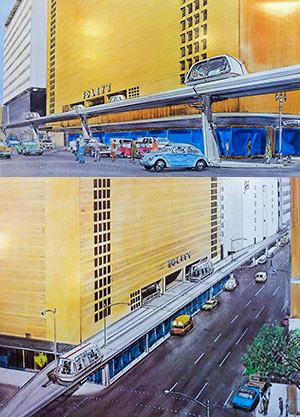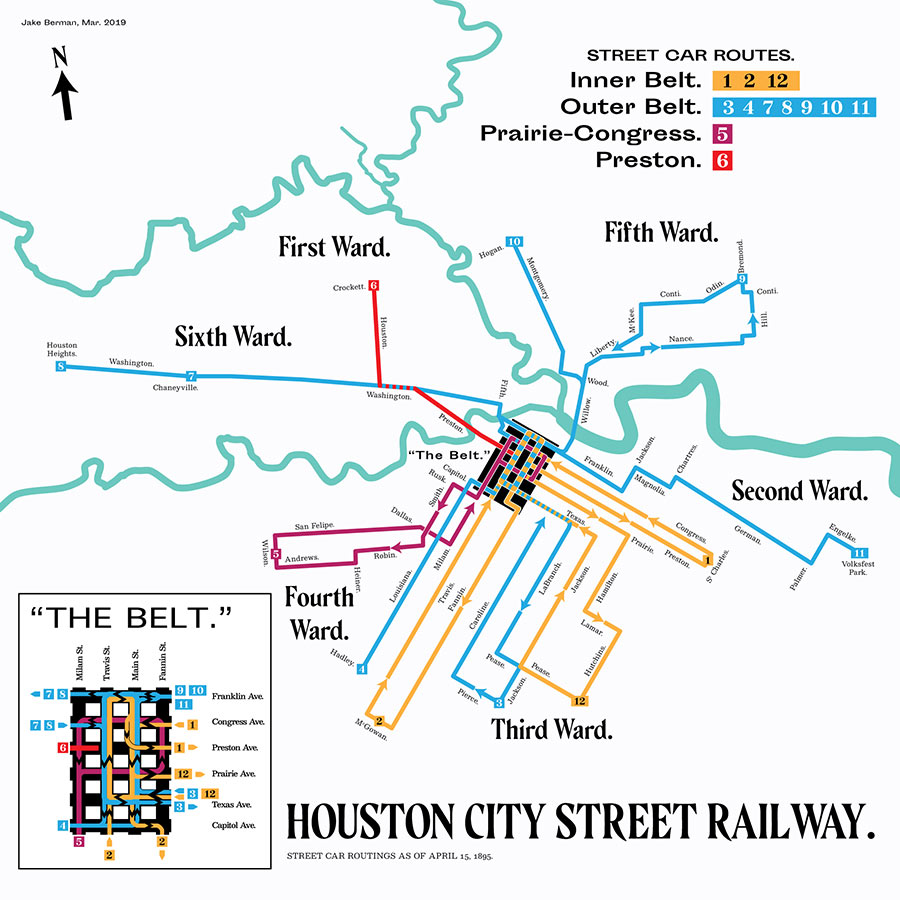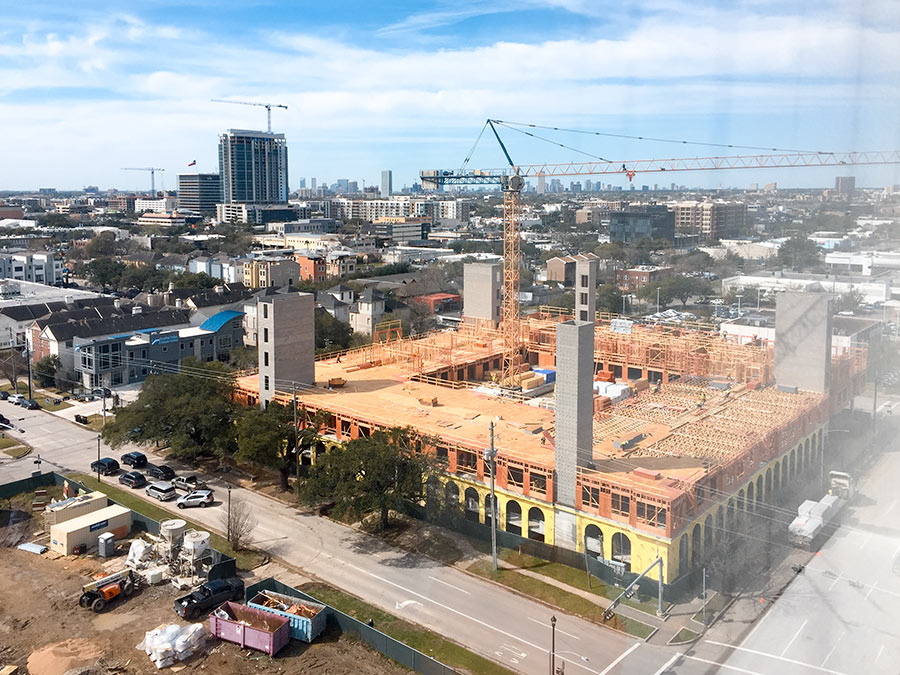WHEN HOUSTON HAD A PLAN, AND FUNDING, FOR A DOWNTOWN PEOPLE MOVER  Digging into 40-some-year-old documents resting comfortably in the Houston Metropolitan Research Center at the Julia Ideson Library, Christopher Andrews pieces together the story behind the Downtown People Mover once planned for Houston. Houston was approved to receive $33 million in federal funding for the project in the mid-seventies, along with 4 other cities, but withdrew its application shortly after Harris County voters approved the creation of Metropolitan Transit Authority in 1978. After Houston dropped out (along with Cleveland and St. Paul), actual downtown people movers ended up getting built in Detroit and Miami. “The City of Houston’s 1976 proposal to the UMTA,” writes Andrews, “called for a 1.09 mile system, composed of 2.25 lane miles of track bisecting the ‘heart of the downtown core,’ stretching from the Cullen Center to the Harris County complex. It was intended to be fully owned, operated, planned and financed by the City of Houston, and was said to garner ‘strong and wide local support.'” A later report commissioned by the city showed alternatives to that north-south route along Milam St., including an elevated line running down Main St. past (and into) the (recently demolished) Foley’s building. [Not of It] Renderings: Sperry Systems Management/Houston Metropolitan Research Center
Digging into 40-some-year-old documents resting comfortably in the Houston Metropolitan Research Center at the Julia Ideson Library, Christopher Andrews pieces together the story behind the Downtown People Mover once planned for Houston. Houston was approved to receive $33 million in federal funding for the project in the mid-seventies, along with 4 other cities, but withdrew its application shortly after Harris County voters approved the creation of Metropolitan Transit Authority in 1978. After Houston dropped out (along with Cleveland and St. Paul), actual downtown people movers ended up getting built in Detroit and Miami. “The City of Houston’s 1976 proposal to the UMTA,” writes Andrews, “called for a 1.09 mile system, composed of 2.25 lane miles of track bisecting the ‘heart of the downtown core,’ stretching from the Cullen Center to the Harris County complex. It was intended to be fully owned, operated, planned and financed by the City of Houston, and was said to garner ‘strong and wide local support.'” A later report commissioned by the city showed alternatives to that north-south route along Milam St., including an elevated line running down Main St. past (and into) the (recently demolished) Foley’s building. [Not of It] Renderings: Sperry Systems Management/Houston Metropolitan Research Center





This plan is sooooo much smarter than the current rail system we’re building. It’s elevated!!! I’m so sick and tired of wasting time sitting at odd cycling lights because a glorified bus is on the way eventually. I’m all for public transport, but what we have now is just clumsy.
Anyone know if this was before or after the tunnel system?
No ground floor retail. Wouldn’t have used.
@Charlie: Did you read the article? Have you seen how much it costs to run Detroit’s People Mover? If you’re tired of sitting in traffic you should consider using mass transit. Otherwise, you’re just creating more traffic.
I’ve ridden the elevated people mover in Miami, it’s total s%*t. Slow, and being elevated doesn’t help anyone. Good thing Houston pulled out of the plan. The current system will work when enough lines (including ones to the bloody airports) are finished and a person can get close to anywhere in the city. When that happens, inner loopers at least will likely ride it more frequently.
If Houston were to do an elevated anything, this is what planners might want to look at. Elevating the bike lanes would make it much safer for cyclists.
http://www.wired.com/2014/08/copenhagens-new-bike-skyway-makes-commuting-look-fun/#slide-id-1379351
I am fascinated by those renderings with Foley’s – like that was a real anchor point and popular destination! My how things change.
That’s really more of a Shelbyville idea.
Light rail is a joke. Build and elevated, automated people mover down every major thoroughfare in the city. THAT is the only way to get people out of the their cars. It has to be ubiquitous.
Light rail to the airport??? Please. The current choo-choo averages 12 MPH. I don’t have all day to get to IAH. Neither does any other productive person.
I think we’re capable of doing fiscally better than Detroit. I’ve ridden the light rail plenty of times, as well as busses. I think the busses are faster, and they don’t mess up traffic. Carbon footprint, anybody?
I had a visitor in town last month who asked why so many of our downtown buildings had second level lobbies. He reasoned it was a response to the threat of flooding. I told him I had always heard of an elevated planned people mover, but wasn’t sure which was the chicken and which was the egg. Seeing the renderings in this blog entry seems to confirm some definite intent, especially the Allen Center stations. Many of the downtown buildings built in the Seventies have second level lobbies and the 1970s master planned developments (Allen Center, Houston Center, Cullen Center) are tied together with skywalks rather than expanding the tunnel system. Were these buildings influenced by the potential people mover or was it a coincidental trend at the time to elevate the masses?
***insert edgy train hating comment here!!!***
at least we can all agree that at-grade rail is a joke, doesn’t do anything to improve pre-existing transit patterns and comes with a higher carbon footprint than buses (just think of all those years of heavy industry tearing up the streets). however, elevated rail comes at a much higher cost than houston could support even with an actual interest/committed dedication to mass transit that we’re still lacking.
***
now if we raised gas taxes to actually support existing and new infrastructure that will be needed moving forward I can guarantee you there’d be more interest. that needs to be the start, all other efforts are futile. you’d think that in a state like Texas we’d be more than happy to let the free market do the heavy lifting and stop wasting government money on unsustainable motives, but apparently not.
@ Glen W:
The tunnel system was in place and fairly large in 1978.
I love trains. I support mass transit. I have lived here for a quarter century and can confidently state that Houston does not do well with plans… whether ’70s People Movers or Metro’s designs or pie-in-the-sky bullet trains to Dallas.
NO PLANNING!
My analogy is the workman who speaks well, writes just fine, yet completely disregards a drawing on a piece of paper. Is it paper-allergy? Seems like because as soon as you write it down or draw it up, this person goes blank and – in some sort of zombie mode – just does the work however feels right…
***insert hipstery “trains fix all” comment here!!***
I for one will be very interested to see how the two light rail lines will cross each other at Main and Capitol/Rusk later this year…………..
@Walker: It’s really not that interesting:
http://www.translationdirectory.com/images_articles/wikipedia/railroads/Railroad_crossing_at_grade_also_known_as_a_diamond.jpg
Looks a lot like the West Virginia people mover that’s been operating since the same decade. A concept that was considered cutting edge and revolutionary, but still has yet to move beyond it’s first (highly praised) system. What a shame this never happened.